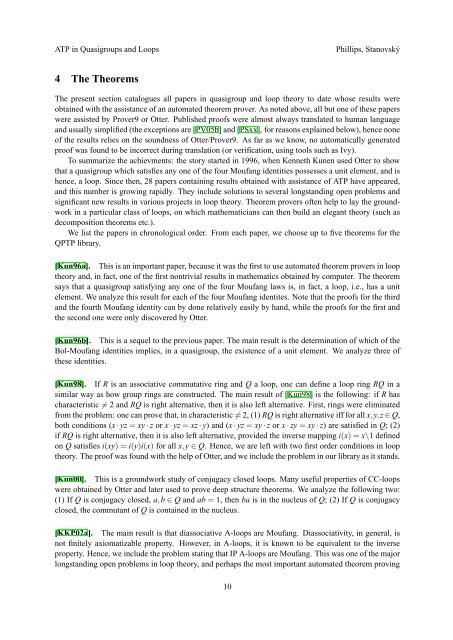Automated Theorem Proving in Quasigroup and Loop Theory
Automated Theorem Proving in Quasigroup and Loop Theory
Automated Theorem Proving in Quasigroup and Loop Theory
You also want an ePaper? Increase the reach of your titles
YUMPU automatically turns print PDFs into web optimized ePapers that Google loves.
ATP <strong>in</strong> <strong>Quasigroup</strong>s <strong>and</strong> <strong>Loop</strong>s<br />
Phillips, Stanovský<br />
4 The <strong>Theorem</strong>s<br />
The present section catalogues all papers <strong>in</strong> quasigroup <strong>and</strong> loop theory to date whose results were<br />
obta<strong>in</strong>ed with the assistance of an automated theorem prover. As noted above, all but one of these papers<br />
were assisted by Prover9 or Otter. Published proofs were almost always translated to human language<br />
<strong>and</strong> usually simplified (the exceptions are [PV05b] <strong>and</strong> [PSxx], for reasons expla<strong>in</strong>ed below), hence none<br />
of the results relies on the soundness of Otter/Prover9. As far as we know, no automatically generated<br />
proof was found to be <strong>in</strong>correct dur<strong>in</strong>g translation (or verification, us<strong>in</strong>g tools such as Ivy).<br />
To summarize the achievments: the story started <strong>in</strong> 1996, when Kenneth Kunen used Otter to show<br />
that a quasigroup which satisfies any one of the four Moufang identities possesses a unit element, <strong>and</strong> is<br />
hence, a loop. S<strong>in</strong>ce then, 28 papers conta<strong>in</strong><strong>in</strong>g results obta<strong>in</strong>ed with assistance of ATP have appeared,<br />
<strong>and</strong> this number is grow<strong>in</strong>g rapidly. They <strong>in</strong>clude solutions to several longst<strong>and</strong><strong>in</strong>g open problems <strong>and</strong><br />
significant new results <strong>in</strong> various projects <strong>in</strong> loop theory. <strong>Theorem</strong> provers often help to lay the groundwork<br />
<strong>in</strong> a particular class of loops, on which mathematicians can then build an elegant theory (such as<br />
decomposition theorems etc.).<br />
We list the papers <strong>in</strong> chronological order. From each paper, we choose up to five theorems for the<br />
QPTP library.<br />
[Kun96a]. This is an important paper, because it was the first to use automated theorem provers <strong>in</strong> loop<br />
theory <strong>and</strong>, <strong>in</strong> fact, one of the first nontrivial results <strong>in</strong> mathematics obta<strong>in</strong>ed by computer. The theorem<br />
says that a quasigroup satisfy<strong>in</strong>g any one of the four Moufang laws is, <strong>in</strong> fact, a loop, i.e., has a unit<br />
element. We analyze this result for each of the four Moufang identites. Note that the proofs for the third<br />
<strong>and</strong> the fourth Moufang identity can by done relatively easily by h<strong>and</strong>, while the proofs for the first <strong>and</strong><br />
the second one were only discovered by Otter.<br />
[Kun96b]. This is a sequel to the previous paper. The ma<strong>in</strong> result is the determ<strong>in</strong>ation of which of the<br />
Bol-Moufang identities implies, <strong>in</strong> a quasigroup, the existence of a unit element. We analyze three of<br />
these identities.<br />
[Kun98]. If R is an associative commutative r<strong>in</strong>g <strong>and</strong> Q a loop, one can def<strong>in</strong>e a loop r<strong>in</strong>g RQ <strong>in</strong> a<br />
similar way as how group r<strong>in</strong>gs are constructed. The ma<strong>in</strong> result of [Kun98] is the follow<strong>in</strong>g: if R has<br />
characteristic ≠ 2 <strong>and</strong> RQ is right alternative, then it is also left alternative. First, r<strong>in</strong>gs were elim<strong>in</strong>ated<br />
from the problem: one can prove that, <strong>in</strong> characteristic ≠ 2, (1) RQ is right alternative iff for all x,y,z ∈ Q,<br />
both conditions (x · yz = xy · z or x · yz = xz · y) <strong>and</strong> (x · yz = xy · z or x · zy = xy · z) are satisfied <strong>in</strong> Q; (2)<br />
if RQ is right alternative, then it is also left alternative, provided the <strong>in</strong>verse mapp<strong>in</strong>g i(x) = x\1 def<strong>in</strong>ed<br />
on Q satisfies i(xy) = i(y)i(x) for all x,y ∈ Q. Hence, we are left with two first order conditions <strong>in</strong> loop<br />
theory. The proof was found with the help of Otter, <strong>and</strong> we <strong>in</strong>clude the problem <strong>in</strong> our library as it st<strong>and</strong>s.<br />
[Kun00]. This is a groundwork study of conjugacy closed loops. Many useful properties of CC-loops<br />
were obta<strong>in</strong>ed by Otter <strong>and</strong> later used to prove deep structure theorems. We analyze the follow<strong>in</strong>g two:<br />
(1) If Q is conjugacy closed, a,b ∈ Q <strong>and</strong> ab = 1, then ba is <strong>in</strong> the nucleus of Q; (2) If Q is conjugacy<br />
closed, the commutant of Q is conta<strong>in</strong>ed <strong>in</strong> the nucleus.<br />
[KKP02a]. The ma<strong>in</strong> result is that diassociative A-loops are Moufang. Diassociativity, <strong>in</strong> general, is<br />
not f<strong>in</strong>itely axiomatizable property. However, <strong>in</strong> A-loops, it is known to be equivalent to the <strong>in</strong>verse<br />
property. Hence, we <strong>in</strong>clude the problem stat<strong>in</strong>g that IP A-loops are Moufang. This was one of the major<br />
longst<strong>and</strong><strong>in</strong>g open problems <strong>in</strong> loop theory, <strong>and</strong> perhaps the most important automated theorem prov<strong>in</strong>g<br />
10
















